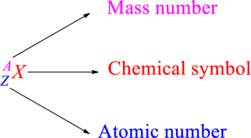
Interpretation:
Partial columns has to be filled in the table given in problem statement.
Concept Introduction:
Each and every element present in the Periodic table has a unique name. Some of the elements are named considering their
Chemical names are represented as atomic symbols. In the symbols, the mass number and atomic number are shown. The complete

Atomic number is the total number of protons present in the atom of an element. Mass number is the total number of protons and neutrons present in nucleus of an atom.
Explanation of Solution
For entry 1:
Number of protons is given as 31. This means that the atomic number of the species is 31. The element with atomic number 31 is found to be gallium with the symbol of
Mass number is the sum of number of protons and number of neutrons. From the mass number given as 70, the number of neutrons can be calculated as shown below.
Number of electrons is given as 28. The charge on the species can be calculated as shown below.
The symbol for the species is given as
For entry 2:
Number of electrons is given as 42. Charge on the species is given as
Number of protons is found as 45. This means that the atomic number of the species is 45. The element with atomic number 45 is found to be rhodium with the symbol of
Mass number is the sum of number of protons and number of neutrons. From the mass number given as 103, the number of neutrons can be calculated as shown below.
The symbol for the species is given as
For entry 3:
Atomic number is given as 49. This means that the number of protons in the species is 49. The element with atomic number 49 is found to be indium with the symbol of
The charge on the species is given as
Mass number is the sum of number of protons and number of neutrons. Number of neutrons is given as 65. From this mass number can be calculated as shown below.
The symbol for the species is given as
For entry 4:
Symbol is given as
Mass number is the sum of number of protons and number of neutrons. From the mass number given as 40 in the symbol, the number of neutrons can be calculated as shown below.
Charge is given as
Complete table can be given as shown below.
| Symbol | ||||
| Atomic number | ||||
| Mass number | ||||
| Charge | ||||
| Number of protons | ||||
| Number of electrons | ||||
| Number of neutrons |
Want to see more full solutions like this?
Chapter 2 Solutions
Chemistry: Principles and Practice
- Complete the following table by filling in the blanks in each row. The first row has been completed as an example.arrow_forwardGive three examples of gaseous elements that exist as diatomic molecules. Give three examples of gaseous elements that exist as monatomic species.arrow_forwardTwo samples of different compounds of nitrogen and oxygen have the following compositions. Show that the compounds follow the law of multiple proportions. What is the ratio of oxygen in the two compounds for a fixed amount of nitrogen? Amount N Amount O Compound A 1.206 g 2.755 g Compound B 1.651 g 4.714 garrow_forward
- Two samples of different compounds of sulfur and oxygen have the following compositions. Show that the compounds follow the law of multiple proportions. What is the ratio of oxygen in the two compounds for a fixed amount of sulfur? Amount S Amount O Compound A l.210g 1.811 g Compound B 1.783 g 1.779 garrow_forwardMatch these by placing the correct notation in the appropriate blank. 3467Se3367As3567Br3672Kr a. Contains 33 neutrons b. Contains greatest number of neutrons c. Contains equal number of protons and neutrons d. Contains the same number of neutrons as there are protons in As-67arrow_forwardWhite phosphorus is available in sticks, which have a waxy appearance. This is a molecular substance, P4. When this solid is vaporized, it first forms P4 molecules; but at high temperature, P2 molecules are formed. How do the molecules of white phosphorus and those of the hot vapor differ? How are the molecules alike?arrow_forward
 Chemistry: Principles and PracticeChemistryISBN:9780534420123Author:Daniel L. Reger, Scott R. Goode, David W. Ball, Edward MercerPublisher:Cengage Learning
Chemistry: Principles and PracticeChemistryISBN:9780534420123Author:Daniel L. Reger, Scott R. Goode, David W. Ball, Edward MercerPublisher:Cengage Learning Introductory Chemistry: An Active Learning Approa...ChemistryISBN:9781305079250Author:Mark S. Cracolice, Ed PetersPublisher:Cengage Learning
Introductory Chemistry: An Active Learning Approa...ChemistryISBN:9781305079250Author:Mark S. Cracolice, Ed PetersPublisher:Cengage Learning Chemistry for Engineering StudentsChemistryISBN:9781337398909Author:Lawrence S. Brown, Tom HolmePublisher:Cengage Learning
Chemistry for Engineering StudentsChemistryISBN:9781337398909Author:Lawrence S. Brown, Tom HolmePublisher:Cengage Learning Chemistry & Chemical ReactivityChemistryISBN:9781337399074Author:John C. Kotz, Paul M. Treichel, John Townsend, David TreichelPublisher:Cengage Learning
Chemistry & Chemical ReactivityChemistryISBN:9781337399074Author:John C. Kotz, Paul M. Treichel, John Townsend, David TreichelPublisher:Cengage Learning General Chemistry - Standalone book (MindTap Cour...ChemistryISBN:9781305580343Author:Steven D. Gammon, Ebbing, Darrell Ebbing, Steven D., Darrell; Gammon, Darrell Ebbing; Steven D. Gammon, Darrell D.; Gammon, Ebbing; Steven D. Gammon; DarrellPublisher:Cengage Learning
General Chemistry - Standalone book (MindTap Cour...ChemistryISBN:9781305580343Author:Steven D. Gammon, Ebbing, Darrell Ebbing, Steven D., Darrell; Gammon, Darrell Ebbing; Steven D. Gammon, Darrell D.; Gammon, Ebbing; Steven D. Gammon; DarrellPublisher:Cengage Learning Introductory Chemistry: A FoundationChemistryISBN:9781337399425Author:Steven S. Zumdahl, Donald J. DeCostePublisher:Cengage Learning
Introductory Chemistry: A FoundationChemistryISBN:9781337399425Author:Steven S. Zumdahl, Donald J. DeCostePublisher:Cengage Learning





